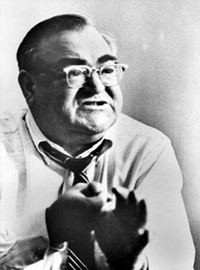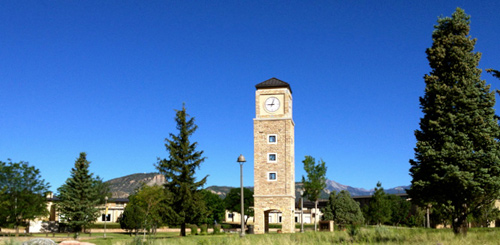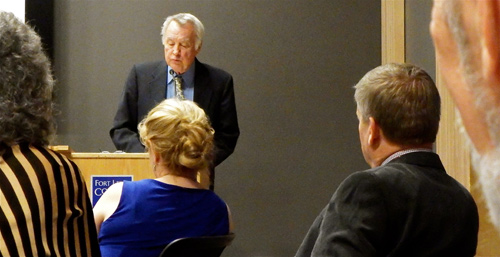My life companion Lynn Axelrod and I have just returned from Durango, Colorado, where we attended an annual conference of the International Society of Weekly Newspaper Editors at Fort Lewis College.
Two posts will deal with our adventures. The second will concern transportation, ranging from driving “the highway to hell” (in the words of the Durango Herald) to travel by old-fashioned steam engine and modern Amtrak. Because this first post deals with my receiving a journalism award, I’ve let Lynn prepare it.
Fort Lewis College in Durango, Colorado, opened in 1891 as a boarding school for Native American Indians and remained so until the 1930s when it became a two-year college. In 1956, it was relocated from the town of Hesperus to its present location 18 miles to the east and became a four-year college. Under federal law, Indian students attend it tuition free. (Photo by Tim Waltner, member of the International Society of Weekly Newspaper Editors and publisher of the Freeman Courier in South Dakota)
By Lynn Axelrod
The highest international award in the English-speaking world for editing a weekly newspaper went to Dave Mitchell of Point Reyes Station last week.
Mitchell, 70, who retired in November 2005, edited and published The Point Reyes Light for 27 years. On June 28, Mitchell received the award in Durango, Colorado, during the annual conference of the International Society of Weekly Newspaper Editors (ISWNE).
Editors from throughout the United States and Canada, as well as from England, Scotland, and Australia, were on hand.
 Mitchell’s “Eugene Cervi Award” is named after the late editor and publisher of the Rocky Mountain Journal in Denver, where some Colorado politicians once called the liberal newspaperman “the most dangerous man in Denver.”
Mitchell’s “Eugene Cervi Award” is named after the late editor and publisher of the Rocky Mountain Journal in Denver, where some Colorado politicians once called the liberal newspaperman “the most dangerous man in Denver.”
Eugene Cervi (at left)
After he died in 1970, the New York Times described Cervi as “one of the most outspoken voices in American journalism,” ISWNE executive director Chad Stebbins has written.
The Eugene Cervi award recognizes “a newspaper editor who has consistently acted in the conviction that good journalism begets good government.”
The award is presented not for a single brave accomplishment, however deserving, but for a career of outstanding public service through community journalism and for adhering to the highest standards of the craft with the deep reverence for the English language that was the hallmark of Gene Cervi’s writing.
The award also recognizes consistently aggressive reporting of government at the grassroots level and interpretation of local affairs.
Chad Stebbins (left), executive director of ISWNE, and Mitchell standing with the Eugene Cervi Award, which is represented by a street-vendor “Newsman.”
Although the four-day conference was held in Colorado this year, ISWNE’s annual conferences are often held abroad: Calgary, Alberta, 1994; London, Edinburgh, Cardiff & Dublin, 1995; Halifax, Nova Scotia, 1999; Victoria, British Columbia, 2000; Galway, Ireland, 2003; Edmonton & Fort McMurray, Alberta, 2005; Charlottetown, Prince Edward Island, 2009; Coventry, England, 2011. In 2016, the group will head to Australia.
In 1979 when Mitchell and his former wife Cathy published The Light, the newspaper received the Pulitzer Prize for Meritorious Public Service. It was only the fourth year since the prizes were established in 1917 that any Pulitzer had gone to a weekly newspaper.
The prize was for an investigation and editorial crusade warning about violence and other illegal activities by the Synanon cult. Synanon, which officially dissolved in 1991, was headquartered on Tomales Bay in Marshall during much of the 1970s.
Mitchell’s new book, The Light on the Coast, which was coauthored by Jacoba Charles, includes key articles and opinion pieces about Synanon. Using news stories published when events occurred, The Light on the Coast tells the history of West Marin since the paper’s founding in 1948. At ISWNE’s request, Mitchell gave an hour-long talk on Synanon and other stories from the book. The Light’s reports on five waves of ethnic immigration to West Marin beginning in the 1850s were a major part of his talk.
Fort Lewis College, which is named after Lt. Col William Lewis, a hero of the Union Army in the Civil War, is in the San Juan Mountains of southwestern Colorado at 6,872 feet in elevation. It borders wildlands, and a small herd of mule deer graze the campus undisturbed.
Nominating Mitchell for the award were San Francisco Chronicle reporter and columnist Carl Nolte, retired Santa Fe Reporter editor and publisher Richard McCord, and California Newspaper Publishers Association executive director Thomas Newton.
Newton praised Mitchell for trying to make The Light the “New York Times of West Marin” and for his “swashbuckling journalism for the Hearst-owned San Francisco Examiner, including trips to El Salvador and Guatemala to cover the upheaval and insurrection of the time [1982-83].”
Commenting on Mitchell’s Pulitzer-winning reporting Nolte wrote, “Synanon was very tough. Big city papers went after the organization but were scared off by threats of lawsuits. But nobody and no lawsuit could stop The Light.”
He added, “Don’t think The Light is a one-trick pony. Mitchell has taken on the Park Service, which runs the [Point Reyes] National Seashore with an iron hand. He has also followed the immigration patterns on the land, from the now nearly vanished Miwok Indians to newer people.
Richard McCord (seen introducing Mitchell at ISWNE’s awards banquet) is best known nationally for his 1996 book The Chain Gang, which exposed the Gannett newspaper chain’s illegal efforts to drive competitors out of business.
In his letter of nomination, McCord focused on The Light’s Synanon exposé: “Despite warnings that he might be in physical danger, Dave Mitchell continued writing about Synanon in stories and editorials.”
During the awards dinner, Mitchell told the crowd he “had thought he was fading away like the old soldiers cited by Gen. Douglas MacArthur in his farewell speech to Congress,” ISWNE’s June 29 newsletter reported. “To me this is like winning a second Pulitzer. It had been so many years since I had put on a tie, I couldn’t remember how to tie it.”




